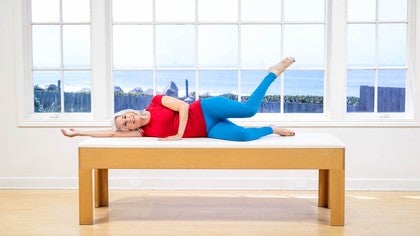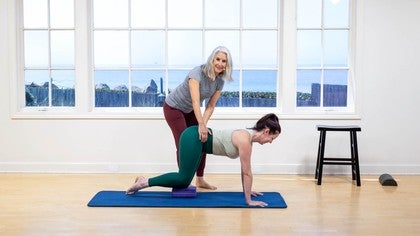Description
About This Video
Transcript
Read Full Transcript
Pelvic Health Lecture
I'm Madeline Black and I'm presenting a pelvic health series. We meet a vast population of people that present a diverse range of physical challenges in the Pilates studio. Many times the person has tried everything and was told to try Pilates to help overcome a physical discomfort. This pelvic health series will focus on general pelvic health and explore what is a healthy pelvis. What are the typical presentations and possible reasons how movement may change and lessen these discomforts?I have invited three people to be the examples where you will observe how to assess, choose movement based on the findings we observed and strengthening exercises on the mat using props and the reformer. A person with a healthy pelvis can navigate their activities with pleasure and physical, improving their overall health. Millions of people at one time or another have pelvic health issues and related pain. Both men and women experienced pelvic health issues. Few people seek treatment, compromising their quality of life.
The embarrassment and emotional associations with pelvic dysfunction are the reason people resist treatment. Pelvic health issues should not be accepted as normal or as part of the aging process. Whether a person is 12 or 80, everyone should learn about pelvic health. Education, awareness and exercise are important tools to teach all people. Pelvic health pertains to all parts of the body below the navel and above the legs called the lumbo-pelvic-hip complex.
Common neuro myofascial skeletal pelvic issues are sacroiliac joint pain, sciatica, anterior hip syndrome, piriformis syndrome, pubic synthesis pain and lateral hip pain. These are best managed through movement sequencing that is based upon evaluating movement patterns, interpreting what is observed and identifying movement habits that are inhibiting good function. A combination of lumbo-pelvic hip resetting movements, strengthening exercises and movement control helps improve pelvic function and decrease pain. The balance between mobility and support is key to a healthy pelvis. Pelvic issues are associated pain, can also from digestive reproductive or urinary systems.
It includes bladder and bowel health, vaginal and uterine health, prostate and testicle health and sexual health. In women pelvic pain or bladder dysfunction begins at the start of menses, roughly the age of nine to 14 years. Chronic pelvic pain is defined as cyclical or non-cyclical pain of at least six months duration that may arise from the Oregon issues and or the structures of the pelvis, such as joints, nerves, muscles, fascia related to the pelvis. Chronic issues such as bladder and bowel control are signs of the pelvic diaphragm dysfunction. The pelvic diaphragm may be hypotonic, weak from laxity or hypertonic, weak from tightness.
Both issues can be addressed through techniques for resetting the tone through release techniques and requires strength of the trunk and hips for better support. In both men and women, stress and lifestyle can both aggravate and exasperate pelvic diaphragm spasm and pain. The pelvic diaphragm is part of a whole neural myofascial system of the trunk. The pelvic and thoracic diaphragms are key structures involved in pelvic issues and discomforts. Addressing the whole system is important when you work with pelvic health issues.
Some people are at higher risk for pelvic diaphragm disorders, such as those with connective tissue disorder, steroid dependency, multiple bursts, a history of pelvic radiation and pelvic surgery. Higher risk patients should undergo evaluation early by a doctor or physical therapist specializing in pelvic care to maintain good pelvic health. Health disparities are social inequities demonstrated in our healthcare system, creating health consequences for those who experience systemic disadvantage due to race, ethnicity, nationality, religion, socio economic status, gender, gender identity, sexual orientation, age size or ability. A 2015 study showed racial disparity in knowledge and curative treatments for pelvic floor disorders. A 2013 studies showed communication barriers of Spanish speaking women with pelvic disorders.
Other people at risk are members of the LGBTQ plus community who struggle to find pelvic health care that affirms their identity and meets their specific needs. A research survey showed many providers report feeling unprepared to care for them with confidence. Proper education and care should be accessible to people of any gender identity. Research suggests that affirming and inclusive healthcare reduces these disparities and can also be a source of support. What helps pelvic health is a balance between mobility and support by strengthening the lumbo-pelvic-hip complex.
Meditation and guided relaxation can help change the tone of overly tight pelvic muscles, avoiding constipation by consuming ample fluids and fiber and exercising regularly. Dietary changes can improve stool consistency, which can help with bowel leakages or painful constipation. Avoid straining or pushing during bowel movements and when urinating. Decrease intake of caffeine, alcohol and artificial sweeteners. Learn how to relax the pelvic diaphragm area.
For example, take warm baths and have a daily movement practice. Challenge the pelvic diaphragm with light bearing down as in coughing, maintain a healthy weight, avoid heavy lifting, which can lead to organ prolapse. Just as people exercise and eat well to help prevent heart disease, obesity and diabetes. They can also work to improve their pelvic health throughout their lives. Teaching people to identify their movement patterns, recognize the postural and movement habits, how to reset the pelvis and practice strengthening on a regular basis will empower them to be proactive about their health.
Anatomy Review
So we're gonna do an Anatomy Review of the lumbo-pelvic-hip complex. And I created this model with two dimensional images of the musculature and you'll see some fascia just like in an anatomy book. And I taped it onto an actual pelvis here so that you can understand and see the relationships of the structures that are related to the hip joint, the pelvis and the lumbar spine. So first from the front, you're gonna see it's the adductors from the medial line of the legs. So that's midline to the body, that comes into the pubic ramus here.And it is continuous with the pelvic diaphragm and continuous through what we call the myofascial core or your abs, okay. So here, we have the external oblique and how it's coming in to the linea alba here, okay. So I'm gonna remove the external oblique. Again, this is a two dimensional images here. The body is actually, you know, really interwoven, so it's not flat layers.
There aren't any layers in the body, but if I peel back the external oblique, this is where we see more of the transverse abdominis here, the transversalis fascia, which is the entire fascia of that myofascial core with the transverse abdominis musculature and the rectus abdominis is superficial up by the rib cage, which comes up as high as your pecs here. And it comes down and then it dives deep into the transverse abdominis, which is more superficial down below. And this is why when we're doing our exercises and doing some movement, when we start to kind of focus on feeling the tone more towards the pubic ramus area in through here, is considered the transverse abdominis tone, which is very important to pelvic health. So we'll take that away and then we'll see, I think I'll just pull it out. There we go.
I spent a lot of time taping this, now we're untaping, there we go. So here, we're gonna see what's more internal here, so you can see the sacrum and the lumbar spine. And so this is the internal oblique here, which wraps around and you can see in the background here, the quadratus lumborum, but you know, it's not in isolation. The whole myofascial core here, you know, is a cylinder that's completely connected and overlapped here. So even though we're identifying individual muscles, it's not how it functions.
So superficially, let's look at the back now. Okay, so we haven't practiced turning, but we're gonna try, there we go, that was pretty good. All right, so now we'll talk about the backside here. So here we have the thoracolumbar fascia, and you can see how the lats come into the fascia here. And it's continuous with the glute max.
So again, the relationship of the latissimus dorsi and the thoracolumbar fascia and the glutes is important to the strengthening and health and balance of the pelvis. And then we're going to, let's look at the pelvic diaphragm from the back since we've got the back view. So we're gonna take that away, okay. And if you could tip it up now, so we're looking at the bottom of the pelvis here. Okay, great, so from the sacrum, we have the thoracolumbar fascia that's come down and it's continuous with the sacrotuberous ligament, which then attaches to the hamstring, which I don't have on this image, but it would be connecting through the hamstring, especially the medial side of the hamstring.
And then you can see the deep rotators of the hip joint coming from the greater trochanter into the pelvic diaphragm. And one of the more significant muscles that is either hypertonic and also be very tight or also weak is the obturator internus. And what you can maybe see here, it's kind of a little difficult to see, but the rotator muscles, especially the obturator internus connects into the levator ani, directly into the pelvic diaphragm. And then you have your piriformis coming in here as well. So you can see this musculature, which is like the floor of the pelvis.
Okay, let's turn it around one more time. And we're gonna tip, I think I'll take these away. Yeah, we'll have to take this away. I did a good job of taping. There, so now we can see inside the pelvic diaphragm here.
So, and you can see that the ligament here and the obturator internus connecting, which is a deep rotator muscle that connects into the pelvic diaphragm. So it's a whole, ball plus there's the parietal fascia that covers the entire bowl of the pelvis here. And then that is also continuous deep into what would be the iliacus and the psoas. So all the structures that come into the pelvis create this kind of like tugging and motion from above and then we have the connection and motion from below. So this is in terms of movement, three-dimensional movement.
We wanna be working on trying to have that balance of the ability for the pelvis to have its movement, but at the same time, have support for your trunk and your organs sitting in that bowl. And we're gonna do that through very specific movements sequencing based on some very simple movement assessments.
Gait Patterning
Gait patterning is one of the most functional movements the human being does. And it's a wonderful way to see how a person has their own strategy for movement. If you watch people walk every day, there are so many varieties of how someone walks, but there's an underlying mechanical way and I don't mean like machine mechanics, but biomechanics, of movement that occurs within the body.And so understanding some simple aspects of this movement pattern, you can then observe someone with their own unique strategy and notice something like, oh, their hip joint is not congruent or is not gliding in the socket as well as it could, which then is affecting, you know, the balance and mobility of the pelvis, which then again, is if we like zoom out, we'll start to affect how the spine is functioning and so on. And restoring some mobility and supporting strength work. We can then support the body and minimize any discomforts and improve their quality of life. So let's take a look at a very simple gait pattern. So if we look at one step.
What happens in the step, is you go into heel stride, but you roll through the foot. Now, as you're doing that, there's a whole spiral that happens in the body, right. So the pelvis is rotating and opposition to the thorax. There's a natural arms swing that happens. And there's a moment of the foot, where you roll through the foot and you kind of push off.
So we wanna see that that kind of motion is happening. And when a person is lacking that thoracic rotation in opposition of the pelvis, when you don't see the thorax moving, then you'll notice things like people walking a little bit here, which is ending up doing over rotation in the lumbar spine and lack of motion of the hip joint, which then distresses the lower back, which then can set up a whole patterning of discomfort with that. So that's just a very simple idea of the gait pattern. Also, when your leg is swinging through to take a step. So I was just showing you the push-off part of the step, but when the leg is swinging through, the pelvis does a little bit of a dipping or listing.
So the pelvis does this like figure eight motion as you're walking, so three-dimensional movement. So if we look at how the ability of one ilium is able to drop and move like this, it's just a few degrees without a lot of shifting through the rib cage here, then we'll know that the hip joint, I'll put that down. All right, so as I drop, I'm creating a pelvis on femur movement here. So you can see how the pelvis is moving over the femur. This femur is now adducting and a little bit of internal rotation to say, so there needs to be this ability of the adduction happening so I know that my leg is able to move and the pelvis has this little bit of listing or dropping, is what I like to say, and you'll notice on yourself and do it in a second, I'll talk you through it.
You're gonna notice on yourself that one side's a little bit easier to allow the ilium to go down than the other and you just make a note of that. And you wanna make sure that you have that ability to drop. It doesn't have to be even to right to left side, but there needs to be some movement. So when the pelvis does that dropping, I grabbed a spring 'cause I'm able to bend it. What can happen is, the lumbar spine will do its side bending and the thorax will go in the opposite direction like this.
And that's a normal kind of motion, and it should happen, as you're walking, it's this kind of spiraling. So with the side bending, there's also rotation. So the spiraling and the ability of your spine to have that motion, it will adapt, you know, with the pelvis. So our pelvic motion in gait patterning is really driven through this spiral of the spine. So if you're walking and not, or moving your spine at all, you know, you might be walking like a puller.
I call this pulling yourself, right. And then I'm not actually implementing that nice, easy flow and motion through the body. And then the musculature and the fascia will all start to get a little stiff and a little dehydrated and will lack the glide and slide it needs to have in order to move. And when we lack that ability to move through the sliding and the gliding, then it's known to show that there can be some pain with that motion. So that's what we're gonna look at.
So why don't you stand up for a moment and try this on yourself. Okay, now stand with your feet in just a neutral position under your pelvis. And you're gonna take your hands and you're gonna place the top of your palm of your hand on the top bones of your pelvis here, and then point your fingers towards your pubic bone. And then just rest your hand there and just see if you can feel a difference between the right side and the left side of your pelvis. And what do you feel?
Well, possibly you feel that one hand is more forward than the other or you can look down and when you look down, you can see that you might be able to see that, you might notice one hand lower than the other like this. And it's very common to have this orientation of the pelvis. And it's very rare that you're actually perfectly even, but if you are yay, that's fantastic. All right, but you know, a slight, it's normal because we live in a world where we're kind of constantly spiraling. So it's not a level thing, don't worry about it, but what's happening in the pelvis here is that, you're, I have this mini pelvis because it has motion to it, as opposed to that big pelvis.
So what can happen is one side can start to rotate forward and the other side rotates backward. And that is really an SI joint motion here, that can happen. So we have a little bit anterior on one side, a little posterior on the other side, the other possibility is the whole pelvis can be in a rotation. So the rotation is coming from the spine, rotating and can be coming from your hip joints, the hip joint. So if I have one hip that's internally rotated and one hip that's kind of sitting in external rotation, my pelvis is gonna orientate in some direction.
So we have to look at the hip joint and the spine. So the hip joint is, look at the pelvis, it's balanced on two balls, if you think about it. Yeah, so when we're standing here, your whole trunk is sitting on these two wobbly balls. So that's why we have the ability to have all this movement in the pelvis. So the other test, so you've got that sense of yourself.
The other one is what I call the hip drop. So you gonna place your hands on the top of your pelvis. See if you can find the bone here and just rest your hands on top. Now, keeping your feet flat on the floor, you're gonna bend, I'm gonna say right knee, my right knee, so I'm gonna bend the knee. And what you'll notice is one side will start to go down.
The the top of your pelvis will lengthen away from the bottom rib. Now, when you do that, if your rib goes with the pelvis, then you didn't create that length here. You moved through the thorax. So notice that, can you bend your knee without your ribs? So maybe place your hands on your ribs.
Can you do that without your ribs shifting this way? It's just to notice that, now the other side, just bend and see if you can feel that lengthening between the rib and the hip without the ribs shifting through there, right. So when you bend, I'm gonna turn around, when you bend your right knee, what's happening, is the pelvis is rotating around the left leg. So that's adduction of the left leg and your lumbar spine is moving towards the lowering hip. Your rib cage should be moving in the opposite direction.
So remember the S I made with the spring, that's what you wanna see. So you wanna compare that to the other side. So when you bend the left knee, this lowers down, the lumbar spine moves that way and your rib cage should move that way. And I've got this ability to roll my pelvis around this leg. So these are the basic movement that should be present in our bodies.
And we can exercise and do specific movements when we feel that that ilium is not dropping down. So what movement can I do to enhance and improve that motion? The other movement you wanna be aware of is a hip sway and a hip sway is just as it sounds. If you place your hands on the side of your pelvis. So here, for those who know the anatomy, it's the greater trochanter here, so place your hands here and then just shift your weight to one side, to one foot.
I'm going to my right foot and what you'll feel. It's like, you're almost gonna take your weight and take a step. So it's just enough of a sway here. And what you will feel is that, the head of the femurs are gonna shift this way. So the greater trochanter comes into your hand over here, and you'll feel the dimple, the deepening of this hip here.
So this femur is moving lateral as this one moves medial. Okay, and that's what happens in the hip sway. So you wanna feel, can I do that motion that pelvis on those two femoral heads or I'm I able to sway from side to side? Now there's a spinal component to this as well, just like the hip drop. So when I sway to the right, what also is happening, is this side of my pelvis is doing the hip drop and my ribs are moving in this direction.
If you do a hip sway and go that way with the ribs, then this ilium is not doing that five degrees or less of a drop, it's a very small little drop. When I sway to the left, I feel the glide of my hip joint. And I should feel that this side goes down, which means my lumbar spine is moving that way and my ribs go that way. So your ribs will go in the direction you're swaying and we should see a little bit of an ilium drop here. This kind of emotion, okay.
So those are the three assessments we're gonna be using with our three models. And then I'm gonna introduce the resetting movement on the mat with the props.
Pelvic Health: Pelvic Assessments and Tips
Comments
You need to be a subscriber to post a comment.
Please Log In or Create an Account to start your free trial.















